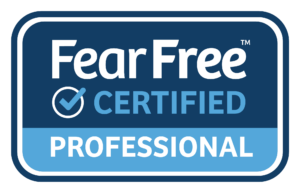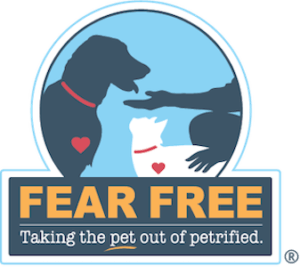
Welcome to the Fear Free Veterinary Certification Program!
As veterinary professionals, we understand the emotional demand of the veterinary field, and we know the impact that stress and anxiety can have on our patients, our team, and our practices. Our goal: Provide veterinary professionals with the tools and knowledge to address different levels of fear, anxiety, and stress; improve client communication; and increase workplace safety.
Fear Free veterinary visits reduce fear, anxiety, and stress and create an experience that is more enjoyable and safer for all involved, including your patients, clients, and team. Learning how to implement Fear Free visits means veterinary teams will see their patients more often, and pet owners will seek advice from them as a trusted source.
This program consists of eight modules, which will need to be taken in consecutive order.
Each module will end with an exam which needs to be successfully completed prior to moving on to the next module. Progress on work can be saved at any time, giving participants the flexibility to self-pace throughout the program. When all eight modules have been completed, the participant will be awarded with a Fear Free certificate.
The purchase of the Fear Free Veterinary Certification Program provides you with an annual membership for the program, which requires an annual renewal fee and completion of additional annual CE to maintain your membership. Be sure to familiarize yourself and your team with the full renewal details for the Fear Free Veterinary Certification Program here.
As a Fear Free Certified Professional, you will:
- Reduce or remove anxiety triggers that can cause pets to become fearful at home, in transport, and at the veterinary hospital
- Help owners deliver calm pets to your hospital
- Enhance the quality of medicine in your practice
- Increase compliance
- Improve safety for the veterinary team

Veterinary Certification Requirements
In order to earn Fear Free certification, veterinary professionals must successfully complete the online certification program. To uphold your certification, you must:
1. Earn 4 additional hours of Fear Free-specific CE annually.
2. Maintain an active membership via an annual renewal fee. Your renewal fee is due annually from the date you initially register and pay for the Fear Free Certification Program. Keep an eye out for reminder emails and instructions on how to pay your renewal fee.

Earning the Elite Fear Free Certified Professional Designation
Becoming an Elite Fear Free Certified Professional is for veterinary members who want to go above and beyond in their commitment to Fear Free. Elite Fear Free Certified Professionals are individuals who are continually committed to a higher level of education. In short, it is an opportunity to set yourself apart from the rest.
The requirements to become an Elite Fear Free Certified Professional are…
- Completion of an individual veterinary certification program
- Completing 35 hours of Fear Free veterinary CE available through the veterinary membership or at industry events and/or conferences
- Continuing to earn 4 additional hours of Fear Free CE annually
- Maintaining an active Fear Free membership via an annual renewal fee
To track your progress toward becoming an Elite Fear Free Certified Professional, follow the CE tracker on your Member Homepage. Once you earn the required 35 Fear Free CE hours, you will receive a congratulatory email (where you can claim your free Elite kit) and an Elite Fear Free Certified Professional badge on your Member Homepage.
I have been in practice for 30 years and this is a game-changer. I have been so pleased at how quickly and effectively I have been able to integrate Fear Free practices into my daily work, even in areas outside of primary care. It has had a significant side effect too: happy, less stressed doctors and staff.
Suzanne Cook Olson, DVM, DACVIM




